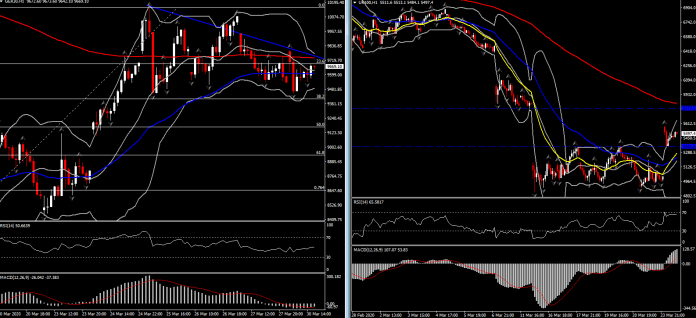The Eurozone ESI confidence index plunged, as did Switzerland’s KOF index, as expected, while German state inflation declined. However all eyes today are still on Trump’s speech along with the US slate which has just February pending home sales and the Dallas Fed manufacturing index.
German HICP inflation fell back to just 1.3% y/y from 1.7% y/y in the previous month. The national rate dropped to 1.4% y/y from 1.7% y/y, with a -0.9% y/y decline in energy prices a driving factor. Goods price inflation also eased markedly as public life is increasingly restricted, although food price inflation jumped to 3.7% y/y and that is likely to go up further, as fresh food prices will go up with farmers across Europe struggling to cope with the lack of seasonal workers, who usually come from other countries.
Despite the European stock markets are up from early lows, are still broadly in negative territory, with the GER30 down 0.75% and the UK100 -0.68%. Spanish IBEX and Italian MIB are underperforming as both countries battle with a still sharply rising death toll and as further restrictions for companies come into effect in Spain. A -7.8 bp decline in Gilt yields led a rally in core EGBs. The German 10-year dropped back -5.2 bp to -0.536%.
The announcement that Toyota announced that it will close all plans in Europe and Russia, with plans in Europe not expected to reopen until April 20 at the earliest, further weigh on European stocks. Along with stocks, Eurozone spreads have widened both signals of continuing risk-off trades.
Markets are clearly not happy with the ECB’s willingness to use OMT and the announcement that the European Stability fund, which offer a sort of “Eurobonds-light” will be strengthened. That may explain while ECB Vice President De Guindos continues to support the creation of “Coronabonds”, which could have a strong signalling effect at a time, when crisis measures trigger a fall back to a focus on national policies.
Germany’s council of economic advisers meanwhile predicts the worst recession since 2009 for this year, although it also sees a relatively strong rebound in 2021. The special report from Germany’s council of economic advisers (SVR) said today that in the baseline scenario of three different outcomes, they expect a contraction of 2.8% this year, followed by a rebound of up to 3.7% in 2021. The baseline scenario assumes that economic activity starts to stabilise over the summer. In a risk scenario that assumes a longer production stop, the model predicts a contraction of 5.4% this year, followed by 4.9% growth next year as demand and production catches up. Clearly all depends on how long restrictions will last, but with the first tests that can reliably say whether someone has had the virus and already built up immunity, Germany is now preparing broad based testing to determine who can go back to work. The reports will help officials to see whether restrictions can be relaxed in coming months.
Looking ahead, consumer confidence, the ADP jobs report, manufacturing ISM, trade, factory orders, and finally, the March BLS employment report are all due. Month- and quarter-end rebalancing is expected to give Wall Street a boost.
Disclaimer: Nothing in this communication contains, or should be considered as containing, an investment advice or an investment recommendation or a solicitation for the purpose of purchase or sale of any financial instrument.
Recommended Content
Editors’ Picks
EUR/USD rises toward 1.0700 after Germany and EU PMI data

EUR/USD gains traction and rises toward 1.0700 in the European session on Monday. HCOB Composite PMI data from Germany and the Eurozone came in better than expected, providing a boost to the Euro. Focus shifts US PMI readings.
GBP/USD holds above 1.2350 after UK PMIs

GBP/USD clings to modest daily gains above 1.2350 in the European session on Tuesday. The data from the UK showed that the private sector continued to grow at an accelerating pace in April, helping Pound Sterling gather strength.
Gold price flirts with $2,300 amid receding safe-haven demand, reduced Fed rate cut bets

Gold price (XAU/USD) remains under heavy selling pressure for the second straight day on Tuesday and languishes near its lowest level in over two weeks, around the $2,300 mark heading into the European session.
Here’s why Ondo price hit new ATH amid bearish market outlook Premium

Ondo price shows no signs of slowing down after setting up an all-time high (ATH) at $1.05 on March 31. This development is likely to be followed by a correction and ATH but not necessarily in that order.
US S&P Global PMIs Preview: Economic expansion set to keep momentum in April

S&P Global Manufacturing PMI and Services PMI are both expected to come in at 52 in April’s flash estimate, highlighting an ongoing expansion in the private sector’s economic activity.
